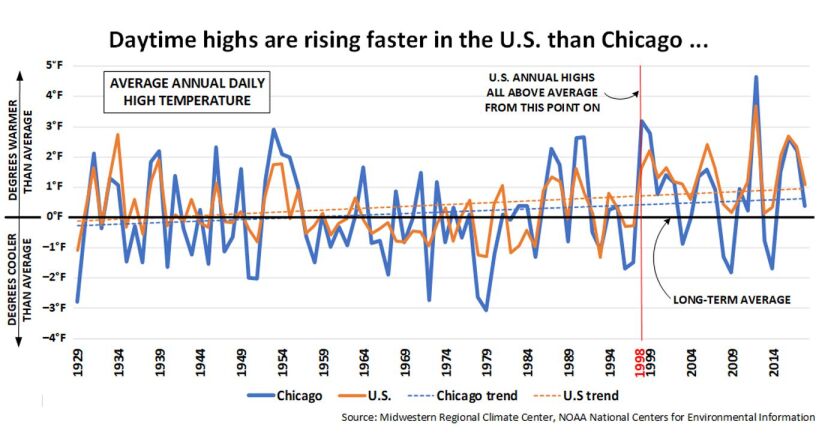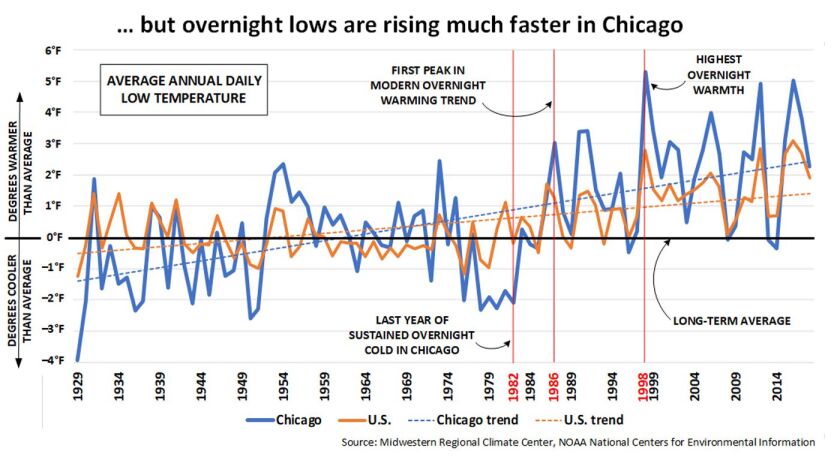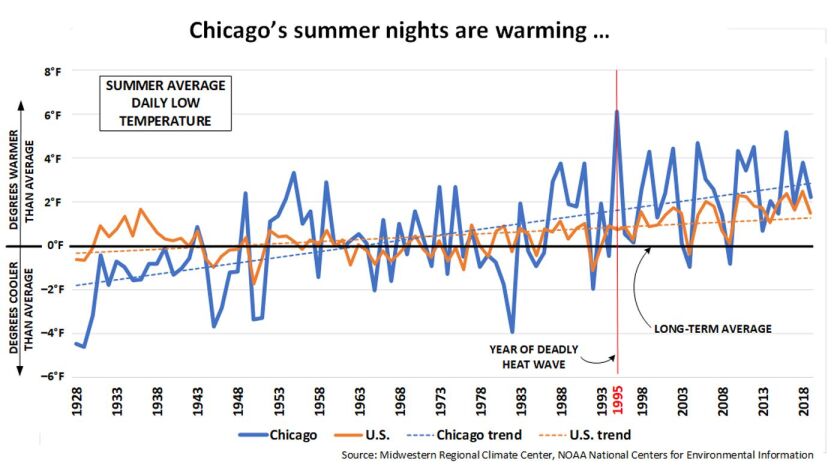After a January of near-record cold and a rainy, chilly spring followed by a summer of mostly moderate temperatures, Chicagoans might be thinking: This isn’t the global warming scenario we were led to expect — that it’s going to get really hot:
As the city’s Chicago Climate Action Plan website says of climate change: “The most obvious change to come could be hotter summers and more frequent and intense heat waves. Hot days could feel even hotter because of higher humidity. More heat waves will mean more heat-related illness and deterioration in the quality of air we breathe.”
The plan, published in 2008, says: “A Chicago summer late in this century could feel like that of Mobile, Alabama, today. By the end of the century, the number of extremely hot days (over 100°F) could increase from the current two days per year to as many as 31 days per year.”
The Union of Concerned Scientists echoes that: “Scientists project that heat-related deaths [in Chicago] are likely to quadruple by 2050. An event like the deadly 1995 heat wave could occur three times a year by the end of this century.”
Other than climate-change deniers, no one is saying such things won’t happen eventually. Chicago and the entire country indisputably are getting warmer, especially over the past 20 years. But the changes are playing out in unexpected ways that, in some respects, are at odds with what’s happening nationwide.
The chart below shows how the average annual daily high temperature in Chicago, as measured at Midway Airport since 1928, departs from the long-term norm compared to the United States overall, based on data from the Midwestern Regional Climate Center at the University of Illinois at Urbana-Champaign and the National Oceanic and Atmospheric Administration’s National Centers for Environmental Information.
Daily highs have been rising in Chicago and nationally — but U.S. highs are rising faster. Beginning in 1998, the yearly average high temperature nationally has been above normal every single year.
Not so in Chicago. The city continues to have colder-than-normal years every so often, though less frequently than it once did.
The next chart shows the average annual daily low temperature for Chicago vs. the nation.
This chart tells a much different story. Daily lows in Chicago have been rising much faster than nationally — a trend that began in the 1980s. Since 1986, Chicago lows have been above normal most years, often outpacing the country as a whole by a wide margin.
To put it another way, the United States is warming up a little faster than Chicago during the day — but Chicago is warming up much faster than the country as a whole at night.
The shift was especially dramatic between 1982, the last in a string of cold years in Chicago, and the unusually warm year of 1998 — by more than seven degrees.
It’s as if someone threw on an extra blanket. And, in a way, that’s what happened. Illinois state climatologist Trent Ford attributes the unexpected warming trend in Chicago and the Midwest generally to higher humidity and more cloud cover. During the day, clouds act as an umbrella, limiting solar heating. At night, they act as a blanket, preventing the warmth from radiating away.
Chicago’s climate tracks most closely with the national trend in winter. During cold-weather months, the city sees greater swings in average temperature from year to year than is true of the entire country, but the city and the nation are warming up at similar rates.
Summers are another matter. Here’s the trend for summertime lows:
And here’s the trend for summertime highs:
Several things jump out.
- The national trend is flat — summertime highs, on average, have changed little in the United States the past 90 years.
- Fluctuations in summertime highs in Chicago, always greater than for the U.S. overall, became more extreme starting in 1983, and the extremes began occurring more frequently.
- Seemingly at odds with the experts’ predictions, the trend in Chicago’s summertime highs is down.
That Chicago has largely dodged the global warming bullet doesn’t mean our luck will hold indefinitely.
“The lack of an upward trend in summer max temperature and projections of more frequent heat waves in Chicago seem paradoxical,” Ford says. “However, climate change works in a non-linear fashion. What we experience today and the changes we’ve seen over the last several decades aren’t necessarily good indicators of what’s to come.
“So it’s entirely credible to state two facts: First, summertime maximum temperatures in Chicago haven’t increased appreciably over the last several decades. And, second, state-of-the-art climate-model projections show considerable increases in the frequency and intensity of summertime extreme heat in Chicago over the next century.”
Here’s why things could start getting a lot worse. As the charts show, Chicago has had some exceptionally hot summers since 1983. What was different about the killer heat wave of 1995 was that, in contrast to other hot summers, the daily highs and lows both were much warmer than the norm, with high humidity. During the hottest stretch, the temperature didn’t drop even at night. That’s why so many — 700 — died.
That doesn’t bode well. Two trends are at work.
- Chicago’s overnight lows are steadily rising.
- And sharp increases in summertime highs, though still relatively rare, are becoming more common.
If those trends continue, hot summer days will be followed more often by hot summer nights.
We’re not there yet. Despite a slow start and some hot days, this summer turned out to be delightful, with plenty of sun, moderate humidity and a pleasant mix of temperatures, hot days followed by cooler ones.
Still, the common view among climate scientists is that we face an unpleasant future in Chicago and worldwide. We need to prepare for the worst — and hope we continue to avoid it.
This is part of the series City at the Crossroads by journalist Ed Zotti, who looks in-depth at trends affecting Chicago and critical choices the city faces.
Email comments to: letters@suntimes.com.










